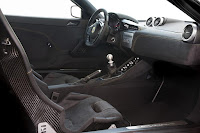Lotus Evora Sport 410 launched
Lotus founder Colin Chapman resolutely took the “to add speed, add lightness” approach when designing his road and race cars. While that philosophy has never really left the company, it's currently being pursued with a renewed vigour.
The latest model to be put through an intensive weight-loss programme is the Evora. What has emerged is the just-announced Sport 410, which is 70 kg (154 lbs) lighter than an Evora 400.
Primarily, this major reduction has been achieved by switching to carbon fibre for various components. They include the front splitter, bonnet access panel, rear diffuser, roof, one-piece tailgate and Alcantara-covered seats.
Power comes from an upgraded supercharged 3.5 litre V6 engine taken from the 3-Eleven. With 410 bhp (306 kW / 416 PS) plus 410 Nm (302 lb/ft) of peak torque, a manual-transmission Sport 410 can accelerate from rest to 62 mph (100 km/h) in 4.2 seconds before going on to a top speed of 186 mph (300 km/h).
Surprisingly, those benchmark performance figures are no different to the regular Evora 400's. But perhaps they don't tell the whole story?
Thanks to extra downforce, a revised suspension geometry, improved dampers and a lower ride height, Lotus says the Sport 410 boasts sharper handling and better body control. Consequently, it should be significantly quicker around a circuit.
One unavoidable downside is a higher price tag. At £79,900, the Evora Sport 410 costs £7,900 more than an Evora 400. However, annual production is being limited to just 150 examples, so supply is unlikely to exceed demand.
Deliveries are scheduled to begin in June.
Related posts:
Lotus introduces the quickest Elise ever
Lotus Exige Sport 350 replaces the Exige S
Lotus Evora 400 or Porsche Cayman GT4?
The latest model to be put through an intensive weight-loss programme is the Evora. What has emerged is the just-announced Sport 410, which is 70 kg (154 lbs) lighter than an Evora 400.
Primarily, this major reduction has been achieved by switching to carbon fibre for various components. They include the front splitter, bonnet access panel, rear diffuser, roof, one-piece tailgate and Alcantara-covered seats.
Power comes from an upgraded supercharged 3.5 litre V6 engine taken from the 3-Eleven. With 410 bhp (306 kW / 416 PS) plus 410 Nm (302 lb/ft) of peak torque, a manual-transmission Sport 410 can accelerate from rest to 62 mph (100 km/h) in 4.2 seconds before going on to a top speed of 186 mph (300 km/h).
Surprisingly, those benchmark performance figures are no different to the regular Evora 400's. But perhaps they don't tell the whole story?
Thanks to extra downforce, a revised suspension geometry, improved dampers and a lower ride height, Lotus says the Sport 410 boasts sharper handling and better body control. Consequently, it should be significantly quicker around a circuit.
One unavoidable downside is a higher price tag. At £79,900, the Evora Sport 410 costs £7,900 more than an Evora 400. However, annual production is being limited to just 150 examples, so supply is unlikely to exceed demand.
Deliveries are scheduled to begin in June.
Related posts:
Lotus introduces the quickest Elise ever
Lotus Exige Sport 350 replaces the Exige S
Lotus Evora 400 or Porsche Cayman GT4?





%2BDashboard.jpg)

+Front+Side.jpg)

+Front+Side.jpg)

Comments
Post a Comment